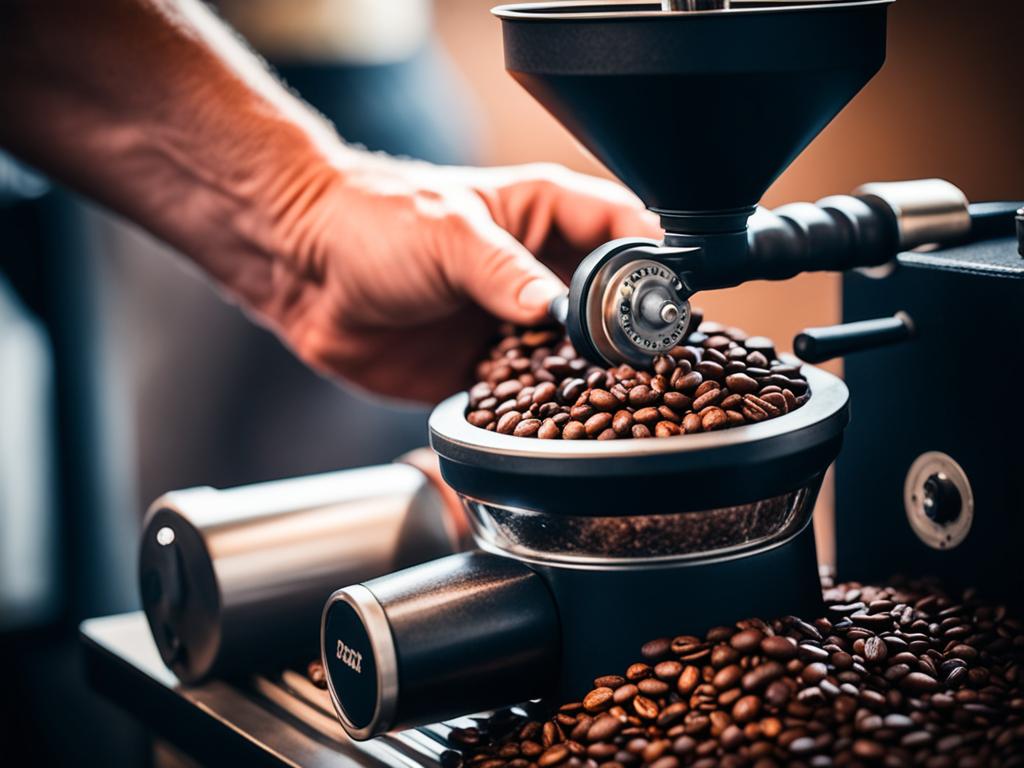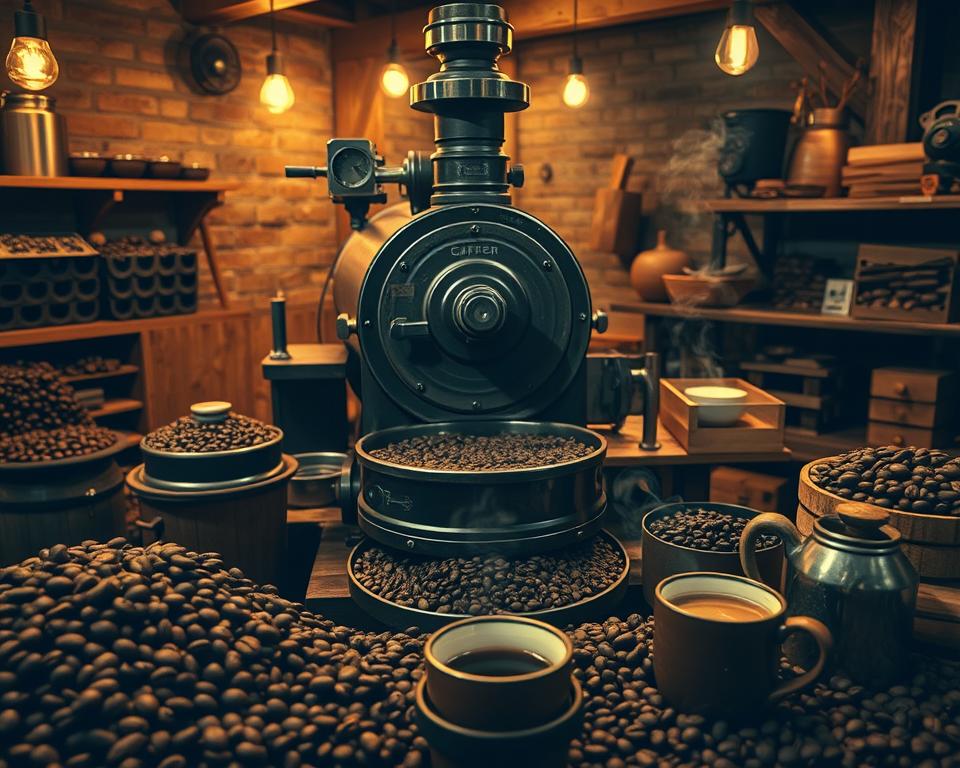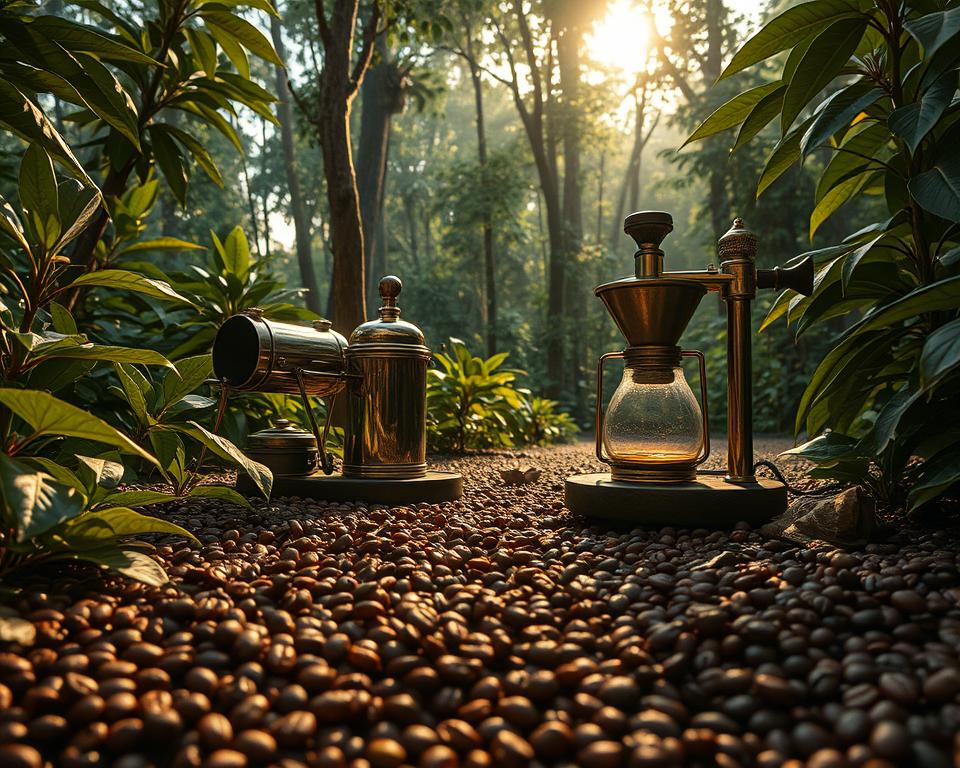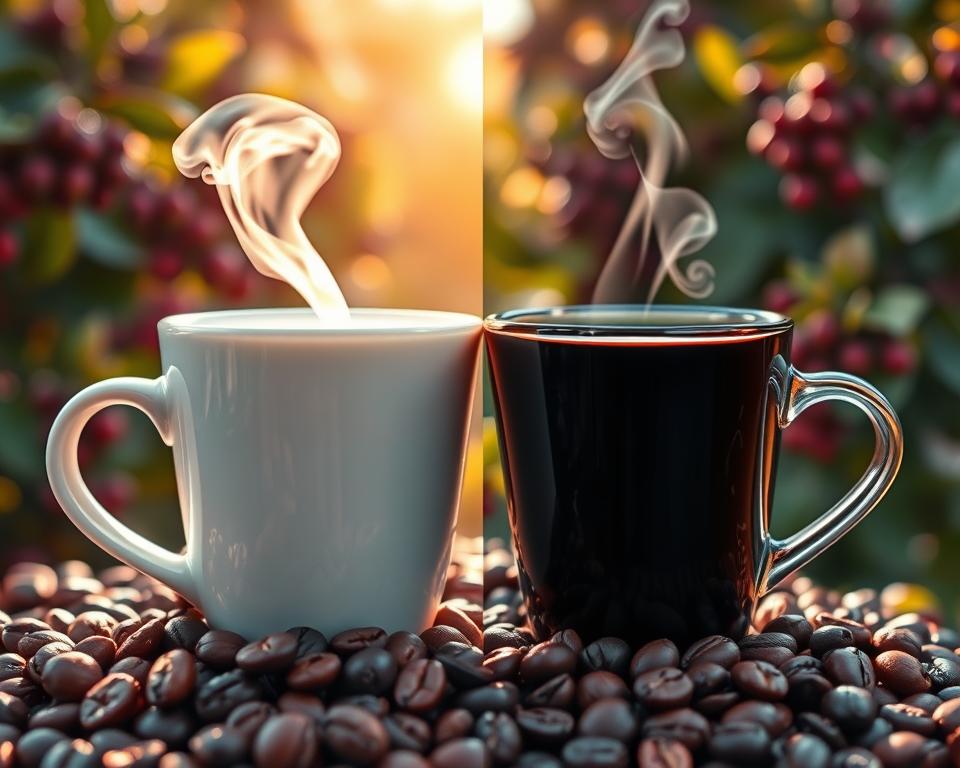Ever wondered if your morning coffee could be more powerful? I’ve pondered how to make coffee stronger while keeping its rich taste. Let me show you how to enhance coffee strength the right way.
It’s not just about using more beans. It’s about the art of choosing and brewing. Follow my tips for a morning coffee that’s bold and flavorful. Ready to change your coffee game and boost coffee flavour?
Choosing the right coffee-to-water ratio is crucial. I’ve learned that a 1-to-16 ratio is usually perfect for brewing stronger coffee. But it’s not all about ratios.
Your brewer type, the coffee’s roast, and the grind size all play roles. Whether you use a Bodum Chambord French Press or a Technivorm Moccamaster, your equipment matters for ways to increase coffee strength.
Here’s a cool tip—tweak a used KCup. By removing its foil and poking a hole at the bottom, you boost pressure. This trick can make your coffee taste like it’s fresh from the machine!
Follow me to learn all about boosting coffee flavour without needing to be a barista.
Key Takeaways
- The recommended coffee-to-water ratio for an optimal brew is 1-to-16.
- Prices for top coffee makers like Bonavita and Technivorm range from $181 to $340.
- French press, pour-over, and espresso machines have varying price points, offering different strengths and flavours.
- D.I.Y. tip: Enhance your brew with a used KCup modification for an unexpectedly potent punch.
- Two tablespoons of coffee grounds are suggested for an ideal, robust flavour.
How do you make coffee stronger? Richness Over Bitterness
How do you make coffee stronger? Many people think stronger coffee means a more bitter taste. Or that it gives a bigger caffeine kick. As a big coffee fan, I’ve learned that true, strong coffee isn’t about being bitter.
It’s about the taste’s depth and intensity.
Defining True Coffee Strength
Here are my top tips for making coffee stronger: For me, strong coffee is rich and full-bodied, like comparing robust red wines to lighter ones. A key tip is getting the coffee-to-water ratio right.
Ever heard of the ‘Golden Ratio’? It suggests using one to two tablespoons of ground coffee for every six ounces of water. This ensures a rich taste without going overboard.
The Myth of Bitter Equals Strong
Some confuse bitterness with strength. But bitter coffee isn’t the goal. To avoid bitterness and still get strong coffee, heat your water to 195 to 205 degrees Fahrenheit.
Not doing this can result in under-extracted or burned coffee.
Strong is Heavy: Coffee Body Matters
When I seek out strong coffee, I look for a heavy mouthfeel. Consider how brewing methods impact coffee. For example, drip systems work best at around 5 minutes, French Press for 2-4 minutes, and espresso only needs 20–30 seconds.
These methods affect the coffee’s texture and body, which are key to a great cup.
To boost coffee strength, remember that freshness is key. Coffee starts losing its taste almost right after brewing.
So, serve it fresh. And keep in mind that the ideal serving temperature is below 140 degrees Fahrenheit. This ensures safety and taste.
| Brew Method | Contact Time | Preferred Strength (TDS) | Water Temperature |
|---|---|---|---|
| Espresso | 20-30 seconds | 7.5%-9.5% | 195°F–205°F |
| Drip/Filter | Approximately 5 minutes | 1.3%-1.7% | 195°F–205°F |
| French Press | 2-4 minutes | N/A | 195°F–205°F |
| Cold Brew | 12-24 hours | N/A | Cold steep |
While we’ve talked about hot brews, don’t overlook cold brews. It’s ideal for those with a sensitive stomach. Cold brew involves steeping coffee in cold water for 12 to 24 hours. It creates a smooth, low-acid drink that’s still strong.
This is because it’s more concentrated. And it’s essential to use the correct coffee-to-water ratio.
So, we’ve explored what makes coffee truly strong. It’s about finding the right balance between a rich body and invigorating flavor. And doing this without any unnecessary bitterness.
How to Make Coffee Stronger: Mastering the Ratio
Improving your coffee’s strength starts with the right coffee-to-water mix. It’s more than just taste. It also enhances the coffee’s richness, smell, and enjoyment.
Let’s explore how to make your coffee stronger by focusing on the perfect ratio and personal taste.
Starting with the standard
The “Golden Ratio” is a good start; it recommends one to two tablespoons of coffee for every six ounces of water. Adjust this starting point to match your taste.
This method helps you find your unique coffee flavor. Also, keep water between 195 and 205 degrees Fahrenheit for the best taste.
Finding Your Perfect Brew Balance
Experimenting is key to finding stronger coffee. Different brewing methods mean different brewing times. You might use a drip system for 5 minutes or try a 12-hour cold brew.
Freshly roasted coffee also makes a big difference. Always go for fresh and in small batches for the best cup.
Common Mistakes to Avoid
Using too much coffee can lead to a bad taste. The goal is a balanced and enjoyable cup of coffee. Remember, too much coffee ruins the flavour.
A good brew balances strength and taste without losing quality or getting too hot.
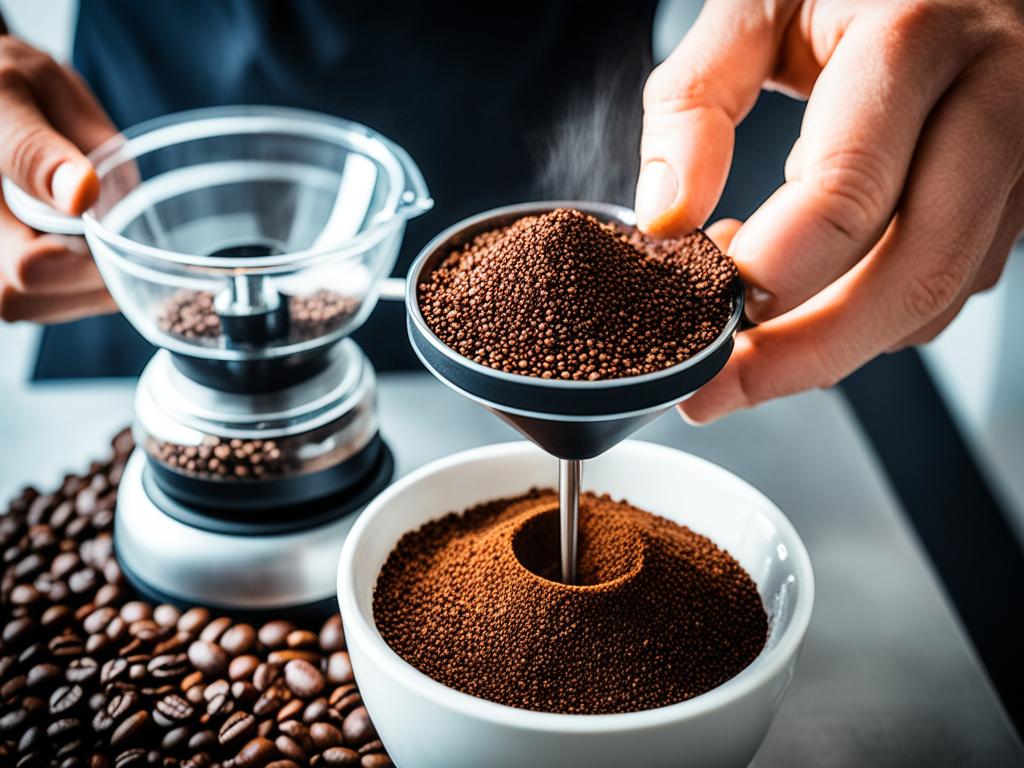
| Brewing Method | Contact Time | Temperature | Caffeine Content | Notes |
|---|---|---|---|---|
| Drip System | Approx. 5 minutes | 195-205°F | 9.7–10.2mg/g | It offers a balanced caffeine level and is great for a standard cup. |
| French Press | 2-4 minutes | 195-205°F | 6.9mg/g | An outlier that provides a lower caffeine content but a richer body. |
| Espresso | 20-30 seconds | 195-205°F | 10.5mg/g | High caffeine concentration for those seeking a vigorous boost. |
| Cold Brew | Steep overnight (12 hours) | Room/Cold | Approx. 150mg/serve | It surpasses espresso in caffeine per serve, ideal for slow-release energy. |
| Filter Coffee | Varies by device | 195-205°F | 9.7–10.2mg/g | Associated with positive cardiovascular outcomes; potentially healthier due to filter-capturing diterpenes. |
Whether you love espresso or cold brew, making coffee stronger is an art. Temperature, time, and coffee freshness all matter. Paying attention to these details can create the perfect, strong coffee.
Choosing Your Beans: Arabica vs. Robusta for Enhancing Coffee Strength
Choosing beans affects your coffee’s strength. Arabica vs. Robusta is more than taste—it’s about their essence. Arabica beans are known for their fine flavours and smoothness.
They are perfect for those who love a gentle cup of coffee. Robusta beans, however, pack a punch with their higher caffeine content. They make for a stronger, more powerful drink.
Roasting plays a big role in coffee strength too. The’strength’ on your coffee bag isn’t just about the type of bean. It also indicates how much the beans have been roasted.
Freshly ground coffee goes stale quickly, but whole beans last longer. Choosing darker roasts for milk-based drinks can enhance their flavour.
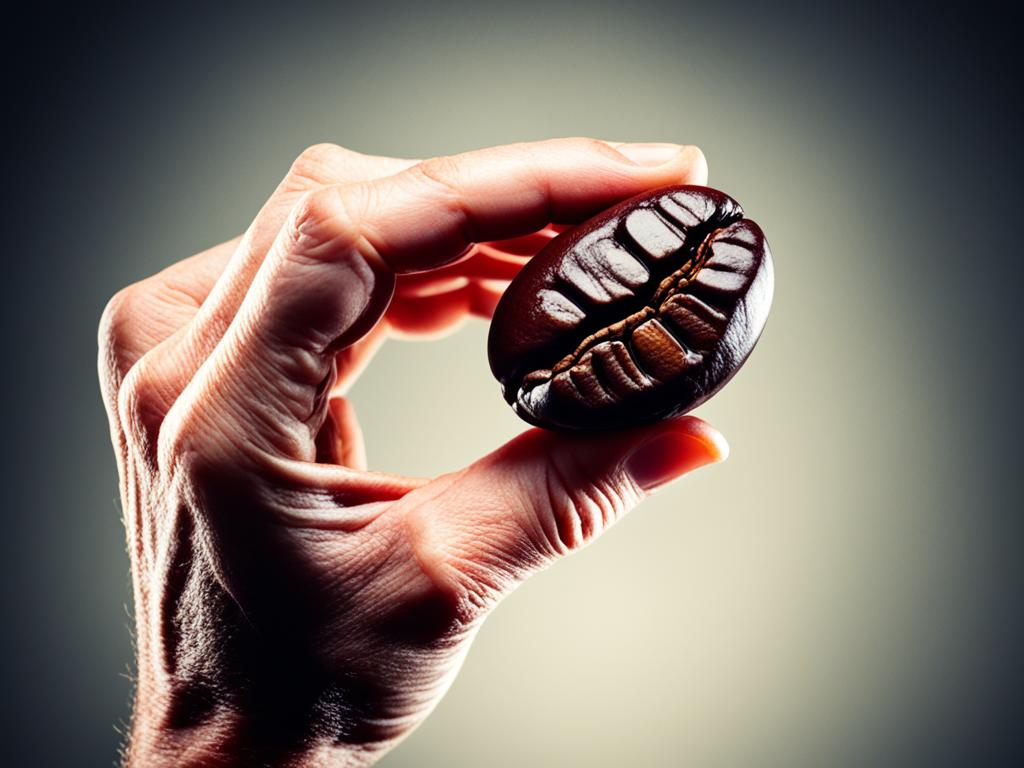
I prefer a robusta-dominant blend for my morning espresso for a stronger kick. Making stronger coffee is a balance. For those who enjoy different tastes, single-origin Arabicas are great.
They offer a taste of their specific growing region. On the other hand, blends bring together various flavours into one cup. Learning about coffee flavours can deepen your understanding of your brew’s taste.
Crafting a Stronger Cup by Adjusting Your Coffee’s Roast Profile
As a coffee lover, I’ve learned that great flavour starts with the roast profile. It’s not just about color. It’s a flavour guide that shapes how strong each sip is.
Understanding coffee roast levels is key for those who love a bold taste.
Decoding Roast Levels for Strength
Coffee-to-water ratios are crucial. Most brewers use a ratio between 1:18 and 1:16. I lean towards 1:16 for a stronger cup. Avoid too high a ratio to dodge bitterness.
Starting at 1:18 and adjusting as needed works best. This method gives a bold cup without a bitter taste.
Why Dark Roasts Reign Supreme in Bold Flavour
Thanks to their deep colour and oily surface, dark roasts offer a rich flavor. These roasts bring forward smoky and chocolaty notes. For the best flavour, enjoy dark roasts within 1 to 2 weeks after roasting.
Water temperature and equipment also play a role. But dark roasts make the most impact for a robust flavor. They are key to a strong and enjoyable cup.
Can the Type of Coffee Filter Used Affect the Strength of My Brew?
The type of coffee filter you use can significantly influence the strength of your brew. Different materials and designs allow varying levels of oils and particles to pass through. For a deeper understanding, check out the “types of coffee filters explained” to see how each option can impact your morning cup.
How to make coffee stronger: The Grinding Game
When enhancing your coffee, the grind size is crucial. It unlocks that rich flavour we all love. Whether it’s your morning start or a late-night espresso, the grind plays a key role.
It determines your coffee’s strength.
The Impact of Grind Size on Coffee Strength
For strong coffee, consistency in grind size is vital. I use a medium grind for flat-bottom filters. For cone-shaped filters, a slightly finer grind is perfect.
The right grind size ensures the best extraction, enhancing each sip.
Comparing Grinders: Blade vs. Burr
Let’s discuss grinders. The choice between burr and blade isn’t just a matter of preference; it’s about getting a precise grind. Burr grinders provide uniformity and cooler grinding.
This avoids overheating from blade grinders, which can hurt your coffee’s taste. It’s what makes your coffee genuinely strong, not bitter.
Freshness Factor: Grind Just Before You Brew
Grinding beans right before brewing is key. It keeps the aromatic oils that make coffee deeply flavorful. Along with proper storage, it’s essential for top-notch coffee.
Keeping beans airtight and away from light and heat is crucial. Master these steps, and you’ll excel in making great coffee.
FAQ
How do I make my coffee stronger without making it bitter?
A better-tasting coffee, without the extra bitterness, needs the right mix of coffee and water. Try starting with a 1:18 ratio (coffee to water). Change it until it tastes just right for you. Do not brew at temperatures over 205°F to avoid bitterness.
What does ‘strong coffee’ actually mean?
When people say ‘strong’, they are talking about its rich, deep, and bold flavor. It’s not just about tasting bitter or having lots of caffeine. The focus is on how intense the coffee flavour is, not just its caffeine kick.
How can I avoid making my coffee taste sour?
Sour coffee often means not enough flavour was extracted from the beans. To fix this, try not to use more than a 1:16 ratio of coffee to water. If it tastes sour, grind the coffee finer or brew it a little longer.
What role does the type of bean play in making strong coffee?
Arabica beans are smoother and more subtle in taste. Robusta beans have a bolder, stronger flavor. For stronger coffee, think about using Robusta beans or a dark-roasted Arabica for its bold taste.
How does the roast level affect the strength of my coffee?
Darker roasts have a stronger flavour than lighter ones. They’re great if you want a bold cup of coffee. Look for roasts labelled “espresso,” “dark,” or “bold” for a stronger taste.
What is the importance of grind size in brewing stronger coffee?
The size of the coffee grind affects how much flavour gets into the water. A finer grind means more flavour, which makes the coffee stronger. Use the right grind size for your brewing method to get the best taste.
Blade or burr grinders: Which is better for making strong coffee?
Burr grinders are better than blade grinders for strong coffee. They grind the beans evenly, which helps extract more flavor. They also generate less heat, keeping the coffee’s flavour intact.
Why should I grind coffee beans just before brewing?
Grinding beans just before brewing keeps the coffee’s flavours and oils fresh. Pre-ground coffee can lose these, making the coffee less tasty. Grind fresh for a strong and flavorful cup.

